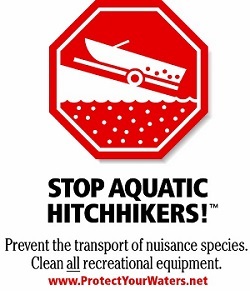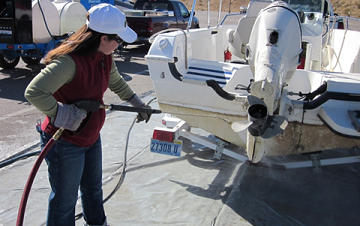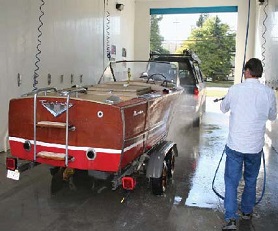Before moving boats between waterbodies:
Watercraft traveling from one waterbody to another are required to follow the Watercraft Decontamination Requirements prior to entering or launching at a waterbody
Watercraft Decontamination Requirements
When hot water rinsing/flushing is available:
Step 1. CLEAN: Remove any plant and animal material from the watercraft and trailer.
- Rinse equipment, boat hulls, and trailer with high pressure, hot water at 140°F (60°C).
- Rinse interior compartments with low pressure, hot water at 120°F (49°C).
- Flush motor and fill/flush ballast tanks (if present) with hot water for 3-5 minutes at 120°F (49°C) or according to owner's manual.
Step 2. DRAIN: Remove all plugs, turn over engine(s) and drain the watercraft thoroughly, including live wells, water boxes, baffles, bilge and ballast tanks, and other water containing compartments, to the fullest extent possible.
When cold water rinsing/flushing is available:
Step 1. CLEAN: Remove any plant and animal material from the watercraft and trailer. Rinse equipment, boat hulls, and trailer; rinse all interior compartments; and flush motor and ballast tanks (if present).
Step 2. DRAIN: Remove all plugs, turn over engine(s) and drain the watercraft thoroughly, including live wells, water boxes, baffles, bilge and ballast tanks to the fullest extent possible.
Step 3. DRY: Let the watercraft dry for at least five days before launching on a different waterbody.
When rinsing/flushing is not available:
Step 1. CLEAN: Remove any plant and animal material from the watercraft and trailer.
Step 2. DRAIN: Remove all plugs, turn over engine(s) and drain the watercraft thoroughly, including live wells, water boxes, baffles, bilge and ballast tanks to the fullest extent possible.
Step 3. DRY: Let the watercraft dry for at least fourteen days before launching on a different waterbody.

Find a Public Access Greeter Station near you with a watercraft decontamination station, see the AIS Map.
Decontamination of watercraft to prevent the overland transport of aquatic invasives is considered to be a very effective spread prevention tool. Beginning in 2016, several watercraft decontamination stations will be operated by the Lake Champlain Basin Program, the Vermont Agency of Natural Resources, and local Public Access Greeters around the state. Courtesy decontaminations will be offered to those boaters looking to ensure that they are not carrying aquatic hitchhikers on their watercraft.
Cooperative Boat Wash Program

In addition to the dedicated boat wash stations, boaters on and around Lake Champlain can also have their watercraft washed at one of the many carwashes in the Champlain basin that participate in our Cooperative Boat Wash Program. The program is designed to help boaters find local car wash stations that are suitable for pressure washing boats, trailers and other equipment. Watercraft and equipment should always be cleaned after use to avoid involuntary transport of invasive plants and animals!
